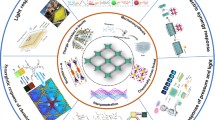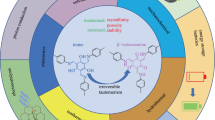Abstract
A new family of silsesquioxane hybrids was synthesized by hydrolytic condensation of a triethoxysilane precursor, R-Si(OCH2CH3)3, R = -CH2CH2CH2N[CH2CH2COOCH2CH2N(CH3)2]2, derived from 2-(dimethylamino)ethyl acrylate. Condensation of the triethoxysilane precursor proceeded as a homogeneous system in methanol in the presence of aqueous HF solution (3.2 %) to afford the water-soluble silsesquioxane hybrid having a high density of chemically bonded peripheral tertiary amino groups on the outermost surface, as confirmed by nuclear magnetic resonance and Fourier transform infrared analyses. The relatively low polydispersity (M w/M n = 1.33) and a reasonable molecular weight (M n = 2700), corresponding to species having 6–12 silicon atoms, were confirmed by size exclusion chromatography. The size of the silsesquioxane hybrid (1.7 nm) was also determined by X-ray diffraction. Co-condensation of tetraethoxysilane (TEOS) with the triethoxysilane precursor was carried out under different feed ratios, and water-soluble products were obtained in the cases of TEOS molar ratio up to 40 %. Quaternization reaction of the tertiary amine-containing hybrids with methyl iodide led to cationic silsesquioxane hybrids containing quaternized amine functionalities, which showed good solubility in polar solvents. Scanning force microscopy measurements indicated the formation of the cationic silsesquioxane hybrids having relatively narrow size distribution with average particle diameter (about 2.0 nm) without aggregation.













Similar content being viewed by others
References
McCusker C, Carroll JB, Rotello VM (2005) Cationic polyhedral oligomeric silsesquioxane (POSS) units as carriers for drug delivery processes. Chem Commun 8:996–998
Cui L, Chen D, Zhu L (2008) Conformation transformation determined by different self-assembled phases in a DNA complex with cationic polyhedral oligomeric silsesquioxane lipid. ACS Nano 2:921–927
Zou Q-C, Yan Q-J, Song G-W, Zhang S-L, Wu L-M (2007) Detection of DNA using cationic polyhedral oligomeric silsesquioxane nanoparticles as the probe by resonance light scattering technique. Biosens Bioelectron 22:1461–1465
Pu K-Y, Li K, Liu B (2010) Cationic oligofluorene-substituted polyhedral oligomeric silsesquioxane as light-harvesting unimolecular nanoparticle for fluorescence amplification in cellular imaging. Adv Mater 22:643–646
Zhao F, Wan C, Bao X, Kandasubramanian B (2009) Modification of montmorillonite with aminopropylisooctyl polyhedral oligomeric silsesquioxane. J Colloid Interface Sci 333:164–170
Wu GJ, Su ZH (2006) Polyhedral oligomeric silsesquioxane nanocomposite thin films via layer-by-layer electrostatic self-assembly. Chem Mater 18:3726–3732
Li Y-C, Mannen S, Schulz J, Grunlan JC (2011) Growth and fire protection behavior of POSS-based multilayer thin films. J Mater Chem 21:3060–3069
Frankamp BL, Fischer NO, Hong R, Srivastava S, Rotello VM (2006) Surface modification using cubic silsesquioxane ligands. Facile synthesis of water-soluble metal oxide nanoparticles. Chem Mater 18:956–959
Nguyen TP, Hesemann P, Tran TML, Moreau JJE (2010) Nanostructured polysilsesquioxanes bearing amine and ammonium groups by micelle templating using anionic surfactants. J Mater Chem 20:3910–3917
Eisenberg P, Erra-Balsells R, Ishikawa Y, Lucas JC, Mauri AN, Nonami H, Riccardi CC, Williams RJJ (2000) Cagelike precursors of high-molar-mass silsesquioxanes formed by the hydrolytic condensation of trialkoxysilanes. Macromolecules 33:1940–1947
Feher FJ, Budzichowski TA (1995) Silasesquioxanes as ligands in inorganic and organometallic chemistry. Polyhedron 14:3239–3253
Voronkov MG, Lavrent’yev VI (1982) Polyhedral oligosilsesquioxanes and their homo derivatives. Top Curr Chem 102:199–236
Pescarmona PP, Maschmeyer T (2001) Oligomeric silsesquioxanes: synthesis, characterization and selected applications. Aust J Chem 54:583–596
Cordes DB, Lickiss PD, Rataboul F (2010) Recent developments in the chemistry of cubic polyhedral oligosilsesquioxanes. Chem Rev 110:2081–2173
Sulaiman S, Bhaskar A, Zhang J, Guda R, Goodson T III, Laine RM (2008) Molecules with perfect cubic symmetry as nanobuilding blocks for 3-D assemblies. Elaboration of octavinylsilsesquioxane. Unusual luminescence shifts may indicate extended conjugation involving the silsesquioxane core. Chem Mater 20:5563–5573
Kannan RY, Salacinski HJ, Butler PE, Seifalian AM (2005) Polyhedral oligomeric silsesquioxane nanocomposites: the next generation material for biomedical applications. Acc Chem Res 38:879–884
Laine RM (2005) Nano-building blocks based on the [OSiO1.5] x (x=6, 8, 10) octasilsesquioxanes. J Mater Chem 15:3725–3744
Mori H, Lanzendörfer MG, Müller AHE, Klee JE (2004) Silsesquioxane-based nanoparticles formed via hydrolytic condensation of organotriethoxysilane containing hydroxy groups. Macromolecules 37:5228–5238
Mori H, Müller AHE, Klee JE (2003) Intelligent colloidal hybrids via reversible pH-induced complexation of polyelectrolyte and silica nanoparticles. J Am Chem Soc 125:3712–3713
Mori H, Lanzendörfer MG, Mülller AHE, Klee JE (2004) Organic–inorganic nano-assembly based on complexation of cationic silica nanoparticles and weak anionic polyelectrolytes in aqueous and alcohol media. Langmuir 20:1934–1944
Schumacher M, Ruppel M, Kohlbrecher J, Burkhardt M, Plamper F, Drechsler M, Müller AHE (2009) Smart organic–inorganic nanohybrid stars based on star-shaped poly(acrylic acid) and functional silsesquioxane nanoparticles. Polymer 50:1908–1917
Muthukrishnan S, Plamper F, Mori H, Müller AHE (2005) Synthesis and characterization of glycomethacrylate hybrid stars from silsesquioxane nanoparticles. Macromolecules 38:10631–10642
Xua J, Shi W (2006) Synthesis and crystallization kinetics of silsesquioxane-based hybrid star poly(ε-caprolactone). Polymer 47:5161–5173
Gunawidjaja R, Huang F, Gumenna M, Klimenko N, Nunnery GA, Shevchenko V, Tannenbaum R, Tsukruk VV (2009) Bulk and surface assembly of branched amphiphilic polyhedral oligomer silsesquioxane compounds. Langmuir 25:1196–1209
Schumacher M, Ruppel M, Yuan J, Schmalz H, Colombani O, Drechsler M, Müller AHE (2009) Smart organic–inorganic nanohybrids based on amphiphilic block copolymer micelles and functional silsesquioxane nanoparticles. Langmuir 25:3407–3417
Bliznyuk VN, Tereshchenko TA, Gumenna MA, Gomza YP, Shevchuk AV, Klimenko NS, Shevchenko VV (2008) Structure of segmented poly(ether urethane)s containing amino and hydroxyl functionalized polyhedral oligomeric silsesquioxanes (POSS). Polymer 49:2298–2305
Mori H, Miyamura Y, Endo T (2007) Synthesis and characterization of water-soluble silsesquioxane-based nanoparticles by hydrolytic condensation of triethoxysilane derived from 2-hydroxyethyl acrylate. Langmuir 23:9014–9023
Mori H, Saito S (2011) Smart organic–inorganic hybrids based on the complexation of amino acid-based polymers and water-soluble silsesquioxane nanoparticles. React Funct Polym 10:1023–1032
Mori H, Saito S, Shoji K (2011) Complexation of amino-acid-based block copolymers with dual thermoresponsive properties and water-soluble silsesquioxane nanoparticles. Macromol Chem Phys 212:2558–2572
Mori H, Miyamura Y, Endo T (2009) Synthesis and characterization of water-soluble SiO1.5/TiO2 hybrid nanoparticles by hydrolytic co-condensation of triethoxysilane containing hydroxyl groups. Mater Chem Phys 115:287–295
Mori H, Sada C, Konno T, Koichiro Y (2011) Synthesis and characterization of low-refractive-index fluorinated silsesquioxane-based hybrids. Polymer 52:5452–5463
Zeng F, Shen Y, Zhu S, Pelton R (2000) Synthesis and characterization of comb-branched polyelectrolytes. 1. Preparation of cationic macromonomer of 2-(dimethylamino)ethyl methacrylate by atom transfer radical polymerization. Macromolecules 33:1628–1635
Brown JF Jr, Vogt LH Jr, Prescott PI (1964) Preparation and characterization of the lower equilibrated phenylsilsesquioxanes. J Am Chem Soc 86:1120–1125
Brown JF Jr, Vogt LH Jr (1965) The polycondensation of cyclohexylsilanetriol. J Am Chem Soc 87:4313–4317
Park ES, Ro HW, Nguyen CV, Jaffe RL, Yoon DY (2008) Infrared spectroscopy study of microstructures of poly(silsesquioxane)s. Chem Mater 20:1548–1554
Bartsch M, Bornhauser P, Calzaferri G, Imhof R (1994) H8Si8O12 — a model for the vibrational structure of zeolite-A. J Phys Chem 98:2817–2831
Jerman I, Vuk AS, Kozelj M, Orel B, Kovac J (2008) A structural and corrosion study of triethoxysilyl functionalized POSS coatings on AA 2024 alloy. Langmuir 24:5029–5037
Ro HW, Park ES, Soles CL, Yoon DY (2010) Structure–property relationships for methylsilsesquioxanes. Chem Mater 22:1330–1339
Sheen Y-C, Lu C-H, Huang C-F, Kuo S-W, Chang F-C (2008) Synthesis and characterization of amorphous octakis-functionalized polyhedral oligomeric silsesquioxanes for polymer nanocomposites. Polymer 49:4017–4024
Laine RM, Roll MF (2011) Polyhedral phenylsilsesquioxanes. Macromolecules 44:1073–1109
Liu C, Liu Y, Shen Z, Xie P, Dai D, Zhang R, He CB, Chung T (2001) Synthesis and characterization of novel alcohol-soluble ladderlike poly(silsesquioxane)s containing side-chain hydroxy groups. Macromol Chem Phys 202:1576–1580
Mantz RA, Jones PF, Chaffee KP, Lichtenhan JD, Gilman JW, Ismail IMK, Burmeister MJ (1996) Thermolysis of polyhedral oligomeric silsesquioxane (POSS) macromers and POSS-siloxane copolymers. Chem Mater 8:1250–1259
Su K, Bujalski DR, Eguchi K, Gordon GV, Ou D-L, Chevalier P, Hu SL, Boisvert RP (2005) Low-k interlayer dielectric materials: synthesis and properties of alkoxy-functional silsesquioxanes. Chem Mater 17:2520–2529
Fasce DP, dell’Erba IE, Williams DJ (2005) Synthesis of a soluble functionalized-silica by the hydrolysis and condensation of organotrialkoxysilanes bearing (β-hydroxy) tertiary amine groups with tetraethoxysilane. Polymer 46:6649–6656
Acknowledgments
This work was supported by Saneyoshi scholarship foundation.
Author information
Authors and Affiliations
Corresponding author
Electronic supplementary material
Below is the link to the electronic supplementary material.
ESM 1
(DOC 2459 kb)
Rights and permissions
About this article
Cite this article
Mori, H., Yamada, M. Synthesis and characterization of cationic silsesquioxane hybrids by hydrolytic condensation of triethoxysilane derived from 2-(dimethylamino)ethyl acrylate. Colloid Polym Sci 290, 1879–1891 (2012). https://doi.org/10.1007/s00396-012-2726-7
Received:
Revised:
Accepted:
Published:
Issue Date:
DOI: https://doi.org/10.1007/s00396-012-2726-7




